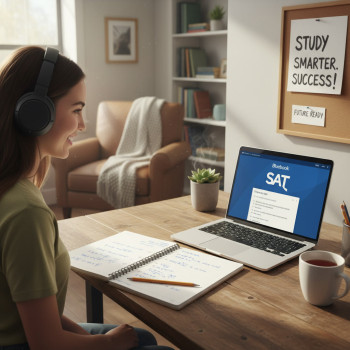Why National SAT Averages Matter—and Why They Don’t Tell the Whole Story
If you’re a parent diving into the college admissions process, the phrase “national SAT average” probably popped up within the first five minutes of your search. It’s a tidy number—easy to glance at and even easier to misinterpret. But before you worry (or celebrate), let’s take a breath and look at what that average actually represents, how colleges use it, and how you can translate it into meaningful action for your student.

What is the “national SAT average”?
The national SAT average is a summary statistic that shows the average combined score (Evidence-Based Reading and Writing + Math) for all test takers in a given year. It’s produced from the pool of students who took the SAT that year and reflects a broad snapshot of performance across the country, not any single school, district, or demographic. Think of it like the national GPA of all SAT test-takers for that year: useful for context, but not definitive for any individual student.
Why the average shifts from year to year
Several factors gently push that national average up or down over time:
- Who takes the test: If more students from diverse academic backgrounds take the SAT in a particular year, the average can shift.
- Test participation changes: Schools that encourage or require SAT participation affect the makeup of test-takers.
- Timing and policy changes: College testing policies, test-optional decisions, and national events can influence participation and preparation.
How Colleges Use the Average (Hint: Often Not as You Think)
Colleges look at many things—grades, rigor of coursework, essays, recommendations, extracurriculars, and yes, test scores. A national average is a backdrop, not a yardstick for admission. Selective colleges publish their admitted students’ score ranges or middle 50% scores; those are far more useful when gauging fit.
Comparing national average to college middle 50%
Here’s a simple distinction to keep in mind:
- National average = big-picture context of how students across the country performed.
- College middle 50% = the score range where 25%–75% of admitted freshmen fall. This is the practical target for admissions to that college.
| Metric | What It Tells You | How Parents Should Use It |
|---|---|---|
| National SAT Average | General average for all test takers | Contextual benchmark; not a college-specific goal |
| College Middle 50% | Where most admitted students score | Use this to set realistic target scores for applications |
| Student’s Personal Best | Individual student’s peak performance | Combine with GPA and activities to craft applications |
What Parents Often Get Wrong—and How to Think Differently
Mistake #1: Treating the national average like a threshold. The national average is not a pass/fail line. Many excellent colleges accept students below the national average, and many students above it still require a compelling application.
Mistake #2: Obsessing over small point differences. A 20-point change is rarely meaningful in isolation. Trends over time and concrete improvements in areas of weakness matter more.
Mistake #3: Ignoring strengths beyond the SAT. Admissions officers evaluate character, resilience, and unique talents. A thoughtful application can make a difference where numbers alone cannot.
How to reframe your thinking
Move from “What is the number?” to “What does this number mean for my child’s opportunities and choices?” Ask: Which colleges are a reach, match, or safety given my student’s full profile? Which programs care most about test scores, and which weigh other factors more heavily?
Practical Steps Parents Can Take
Here’s a step-by-step plan to turn national averages and raw data into useful action.
1. Know the latest national context
Start by checking the most recent national score summary from official sources (College Board/BigFuture). This gives you a baseline to understand where most students fall—but remember to pair it with college-specific middle 50% data.
2. Find your student’s personal baseline
Ask for the student’s best practice test or school-day SAT score. Compare that score to college middle 50% ranges and to the national average to see where they stand.
3. Set a realistic, motivating target
Targets should balance ambition and attainability. A good rule of thumb:
- Safety schools: targets below or near the national average (depending on the school).
- Match schools: targets in the middle 50% range of the school.
- Reach schools: targets above the school’s 75th percentile—but remember, reach is about more than test scores.
4. Create a focused study plan
Knowing the national average helps you prioritize. If your student’s math score lags behind reading, focus time on targeted math practice. Consider shorter, consistent daily sessions rather than marathon weekends—small, structured progress beats last-minute cram sessions.
5. Use official resources—and meaningful supplements
College Board’s BigFuture and SAT Suite pages offer official materials and guidance about scores and preparation. For personalized help, Sparkl’s one-on-one tutoring can fit naturally into a plan: tailored study plans, experienced tutors, and AI-driven insights that track progress and point to where the most score gains can come from.
Interpreting Score Tables: What to Watch For
When you look at school or state score reports, you’ll often see tables and percentiles. Here’s a quick guide to what each column usually implies and how parents should read it.
- Mean/average: The arithmetic average of scores. Good for broad comparisons, less useful for skewed distributions.
- Median: The middle score when all scores are ordered. Less sensitive to outliers than the average.
- Percentiles: Where a score lands relative to other students (e.g., 60th percentile means the student scored better than 60% of test-takers).
- Middle 50% (25th–75th): Useful for college benchmarking—if your student falls in this range, they are statistically similar to typical admits.
Quick example
Imagine the national average is 1040. Your teen scored a 1120. That’s above average—good! But if a college’s middle 50% is 1200–1400, then your student would be in the lower part of that college’s typical admitted range. That doesn’t eliminate the chance of admission—especially if the rest of the application is strong—but it helps you plan whether to retake the SAT or strengthen other parts of the application.
How to Use Averages to Decide Whether to Retake the SAT
Deciding to retake the SAT depends on the gap between current scores and target scores, how much preparation remains, and timing for college applications.
Questions to ask before a retake
- How far is the current score from the college’s middle 50%? (10–20 points is usually not critical; 100+ points might justify a retake.)
- Is there time to meaningfully improve before application deadlines?
- Have targeted weaknesses been identified and are there strategies to address them?
If repeating the test makes sense, use a focused plan: practice tests under timed conditions, targeted review of weak content areas, and perhaps a few sessions with a tutor for strategy and pacing. This is where Sparkl’s tailored study plans and expert tutors can be particularly helpful—because they help the student practice smarter, not just more.
How Demographics and Participation Shape the Average
It’s important to remember the national average is influenced by who took the test. For example, years when more students from a wider range of academic backgrounds took the SAT often show a slightly lower average; years with higher participation from well-prepared students might show a higher average. This doesn’t change how individual colleges view applicants, but it helps parents interpret year-to-year shifts sensibly.
Equity and representation
Because participation varies by region, school policy, and access to prep resources, averages can mask local realities. Parents should pair national context with their child’s school and state data to get a true picture of comparative performance.
Turning Numbers into Narrative: Helping Your Student Tell Their Story
Scores are one piece of a much larger story. Encourage your student to think about their academic narrative: trends in grades, growth in challenging courses, leadership in activities, and resilience in the face of setbacks. A student who has improved over time—and can show how they worked to improve—often makes a stronger impression than a static number on paper.
Concrete ways to build the narrative
- Highlight upward trends in GPA or test scores.
- Show context: a student who improved a lot despite challenges demonstrates grit.
- Use essays and recommenders to convey character, interests, and fit with the college.
When to Lean on Professional Help
Not every student needs a tutor, but many benefit from targeted support—especially when the goal is to bridge a specific gap between current scores and college targets. Tutoring is most effective when it’s individualized: it focuses on specific weaknesses, uses frequent practice and feedback, and adapts as the student improves. That’s the core value Sparkl offers: one-on-one guidance, tailored study plans, and AI-driven insights to focus practice where it will move the needle fastest.
What to look for in a tutor or program
- Diagnostic testing to identify strengths and weaknesses.
- Individualized study plans with measurable goals.
- Experienced tutors who teach test strategy, not just content.
- Progress tracking so you can see real gains over time.
Practical Timeline: From Scores to Applications
Here’s a simple timeline parents can use during junior and senior years to align SAT choices with college application deadlines:
- Junior year spring/summer: take an initial full-length practice SAT to establish a baseline.
- Junior year fall: take the SAT (or PSAT earlier) and review official score reports.
- Junior year winter/spring: targeted practice or tutoring focused on weak areas; consider a retake if needed.
- Senior year fall: final SAT attempt (if needed) well before early application deadlines.
Balancing test prep with other senior-year priorities
Senior year is busy. Prioritize enough prep to meet score targets, but not at the expense of application essays, recommendation letters, or keeping grades strong. A short, focused tutoring plan—especially one that coordinates with the application timeline—can be a smart use of time and resources.
Frequently Asked Questions Parents Ask
Is the national average a good target for my child?
Not necessarily. It’s a contextual benchmark. For many schools, your child should aim for the middle 50% of their chosen colleges rather than the national average.
How many times should a student take the SAT?
Many students take it 1–3 times. The right number depends on how quickly scores improve with targeted study and whether retakes fit the application timeline.
Do colleges care more about SAT scores or GPA?
Colleges consider both—but GPA and course rigor often carry more weight because they reflect sustained academic performance. Test scores provide one standardized data point to compare applicants from different backgrounds.
Final Thoughts: Numbers with Heart
Numbers matter—but they’re only part of the story. The national SAT average gives helpful context, but what matters most is how you and your student use the data: to set realistic goals, to plan smart preparation, and to tell a fuller story in college applications.
If you want a practical next step: gather two things this weekend—your student’s most recent SAT or practice score, and a short list of target colleges. Compare the student’s scores to each college’s middle 50% range. From there, decide if a focused study plan or a few tutoring sessions (the kind Sparkl offers with personalized plans and experienced tutors) would help the student reach their goals. With a thoughtful plan, those numbers become less intimidating and more empowering.

Remember: as a parent, your steady encouragement—paired with clear information and targeted support—can make the college admission journey feel manageable and hopeful. The national average is just a single point on the map. Together with your student, chart the whole route.
















No Comments
Leave a comment Cancel